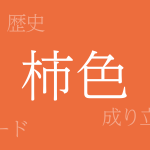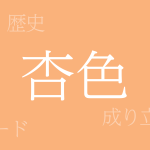Japan’s four seasons are a treasure trove of colors. Spring’s cherry blossoms, summer’s greenery, autumn’s foliage, and winter’s snowscapes enrich our hearts with different hues each season. Within this rich color culture of Japan, “Araigaki (あらいがき – Araigaki)” holds a special place. This pale, gentle color has captivated many people throughout the ages, acting as a mirror reflecting the Japanese sensibility. In this article, we will delve into the fascinating color of Araigaki, exploring its history, shades, and international recognition.
About Araigaki (あらいがき – Araigaki)
Araigaki (あらいがき – Araigaki) is a traditional Japanese color resembling the pale orange of a washed persimmon. The color name is inspired by the hues seen in the ripening process of natural persimmons. As a traditional color, it is used in clothing, everyday items, and fine arts, deeply rooted in the lives of Japanese people.
The History of Araigaki
The Araigaki color has been around since the Heian period, used in a dyeing method known as persimmon tannin dyeing. While it carries a calm elegance, it also conveys vitality and vigor, making it favored by nobility. Over time, as the culture of townspeople developed during the Edo period, it became a beloved color among the broader public, continuing to be cherished by many Japanese to this day.
Araigaki Color Codes
In digital design and web production, accurate color reproduction of Araigaki requires specific color codes. Below are the color codes for Araigaki:
- HEX: #FDD2B9
- RGB: R:253 G:210 B:185
- CMYK: C:0.0 M:17.0 Y:26.9 K:0.8
The Western Name for Araigaki
In English, Araigaki is known as “Persimmon,” which is also the English name for the fruit. True to its name, it features the warm orange of the persimmon fruit. This color is used internationally in interior design and fashion, and its unique shade is loved around the world.
Conclusion on Araigaki
The traditional Japanese color “Araigaki” is distinguished by its unique shade and long history. Symbolizing peace and serenity, this color has deep connections with Japanese nature and culture and continues to be cherished by many today. In the digital age, knowing its color codes allows us to share the color of Araigaki with people worldwide. Araigaki, where tradition and modernity coexist, will continue to add vibrant colors to our lives.

























